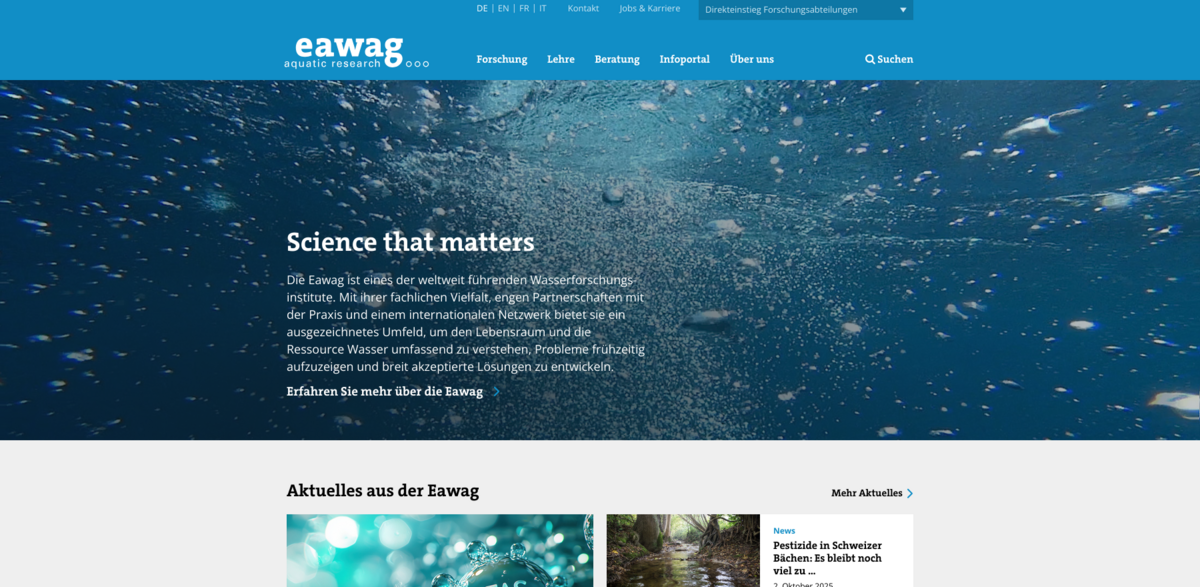What is the Eawag Project?
Eawag is one of the world’s leading water research institutes, part of the ETH Domain. It’s all about diving deep into water research for sustainable prosperity. With a diverse pool of expertise, close partnerships with practice, and an international network, Eawag creates an excellent environment to truly understand water as both a habitat and a vital resource. The goal? To spot problems early and develop solutions that are widely accepted and effective. It’s a place where science meets real-world impact, focusing on everything from aquatic ecology to water transformation.
Main Benefits of the Eawag Project
Here’s what makes Eawag stand out:
- Direct access to specialized research departments like Aquatic Ecology, Fish Ecology & Evolution, and Environmental Chemistry.
- Comprehensive research covering health, drinking water, wastewater, biodiversity, ecosystems, pollutants, climate, and water cycles.
- Close collaboration with practice ensures solutions are practical and widely accepted.
- International network enhances knowledge exchange and innovation.
- Cutting-edge research methods, such as real-time sequencing to study antibiotic resistance in sewage sludge microbiomes.
- Publications like “Wasserwandel” showcase ongoing research and its benefits for people and the environment.
Research Departments and Their Focus
Eawag’s research departments cover a broad spectrum of water-related topics. From Aquatic Ecology to Environmental Toxicology, each department zeroes in on specific aspects of water science. For example, the Fish Ecology & Evolution team studies aquatic life dynamics, while the Systems Analysis & Modeling group works on understanding complex water systems. Urban Water Management tackles challenges in city water infrastructure, and Sanitation & Water for Development focuses on improving water access in developing regions. This diversity allows Eawag to approach water research from multiple angles, ensuring a holistic understanding.
Current Research Highlights
One of the exciting projects underway involves researchers Giulia Gionchetta and Robert Niederdorfer. They’re preparing samples to investigate how antibiotic resistance spreads within the microbiome of sewage sludge. Using real-time sequencing, they’re able to track this phenomenon in unprecedented detail. This kind of research is crucial because antibiotic resistance is a growing global concern, and understanding its pathways in wastewater can help develop strategies to combat it. It’s a perfect example of how Eawag combines advanced technology with pressing environmental issues.
Water Transformation and Its Importance
Water transformation is at the heart of what Eawag researches. The publication “Wasserwandel” highlights what’s being studied and how it benefits both people and the environment. This transformation isn’t just about water quality or availability—it’s about understanding the entire water cycle, including human impacts and natural processes. By shedding light on these complex interactions, Eawag helps guide policies and practices that promote sustainable water use and protect ecosystems. It’s a dynamic field that constantly evolves as new challenges and technologies emerge.
Project Impact on Sustainable Development Goals (SDGs)
- SDG 6: Clean Water and Sanitation – Ensuring availability and sustainable management of water.
- SDG 3: Good Health and Well-being – Addressing water-related health issues through research.
- SDG 13: Climate Action – Studying water’s role in climate resilience and adaptation.
- SDG 14: Life Below Water – Protecting aquatic ecosystems through ecological research.
- SDG 15: Life on Land – Supporting biodiversity and ecosystem health in freshwater environments.
About Eawag’s Navigation and Accessibility
To make all this research accessible, Eawag offers a well-structured navigation system on its website. Important pages like Home, Contact, and Sitemap are easy to find. The dropdown navigation provides direct access to all research departments, making it simple for visitors to explore specific fields. The main navigation guides users through broader topics such as Research, Health, Drinking Water, Wastewater, Biodiversity, Ecosystems, Pollutants, Climate, and Cycles. This user-friendly setup ensures that anyone interested can quickly find the information they need, whether they’re scientists, policymakers, or the general public.





















